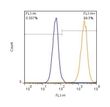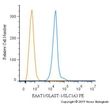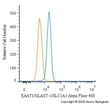EAAT1 (SLC1A3) Rabbit Polyclonal Antibody
Frequently bought together (2)
Transient overexpression lysate of solute carrier family 1 (glial high affinity glutamate transporter), member 3 (SLC1A3), transcript variant 2
USD 436.00
Other products for "EAAT1"
Specifications
| Product Data | |
| Applications | IHC, WB |
| Recommended Dilution | Flow (Intracellular): 1:500, Immunocytochemistry/ Immunofluorescence: 1:10-1:500, Immunohistochemistry: 1:10-1:500, Immunohistochemistry-Frozen: 1:10-1:500, ELISA: 1:100 - 1:2000, Flow Cytometry: 1:200-1:500, Immunohistochemistry-Paraffin: 1:50-1:500, Western Blot: 2 ug/ml |
| Reactivities | Human, Mouse, Rat |
| Host | Rabbit |
| Clonality | Polyclonal |
| Immunogen | A synthetic peptide made to a C-terminal portion of the rat SLC1A3 protein (between residues 500-542) [UniProt P24942] |
| Formulation | PBS, 0.05% Sodium Azide. Store at 4C short term. Aliquot and store at -20C long term. Avoid freeze-thaw cycles. |
| Concentration | lot specific |
| Purification | Immunogen affinity purified |
| Conjugation | Unconjugated |
| Storage | Store at -20°C as received. |
| Stability | Stable for 12 months from date of receipt. |
| Predicted Protein Size | 60 kDa |
| Gene Name | solute carrier family 1 member 3 |
| Database Link | |
| Background | Excitatory amino acid transporter 1 (SLC1A3), also known as sodium-dependent glutamate/aspartate transporter 1, GLAST-1, solute carrier family 1 member 3, EAAT1, and EA6, transports and regulates L-glutamate, D-aspartate, and L-aspartate. SLC1A3 ends the glutamate postsynaptic actions by removing remaining glutamate from the cleft and by reducing extracellular glutamate. SLC1A3 is a member of a family of high affinity sodium-dependent transporter molecules that regulate neurotransmitter concentrations at the excitatory glutamatergic synapses of the mammalian central nervous system. In addition, SLC1A3 may also be important for the prevention of glutamate excitotoxicity. The SLC1A3 protein is located on the cell membrane. SLC1A3 is prominently expressed in the cerebellum, frontal cortex, hippocampus and basal ganglia and is also reported to be found in heart, placenta, lung and striated muscle. The SLC1A3 protein is subject to glycosylation and phosphorylation. SLC1A3 has two known isoforms (59.5 and 55 kDa) formed by alternative splicing. Mutations in the SLC1A3 gene have been linked to episodic ataxia and hemiplegia (PMID: 16116111) while other mutations result in a form of SLC1A3 (E219D) which influences Tourette syndrome (PMID: 21233784). |
| Synonyms | EA6; EAAT1; GLAST; GLAST1 |
| Reference Data | |
| Protein Families | Transmembrane |
Documents
| Product Manuals |
| FAQs |
| SDS |
{0} Product Review(s)
0 Product Review(s)
Submit review
Be the first one to submit a review
Product Citations
*Delivery time may vary from web posted schedule. Occasional delays may occur due to unforeseen
complexities in the preparation of your product. International customers may expect an additional 1-2 weeks
in shipping.






























































































































































































































































 Germany
Germany
 Japan
Japan
 United Kingdom
United Kingdom
 China
China














